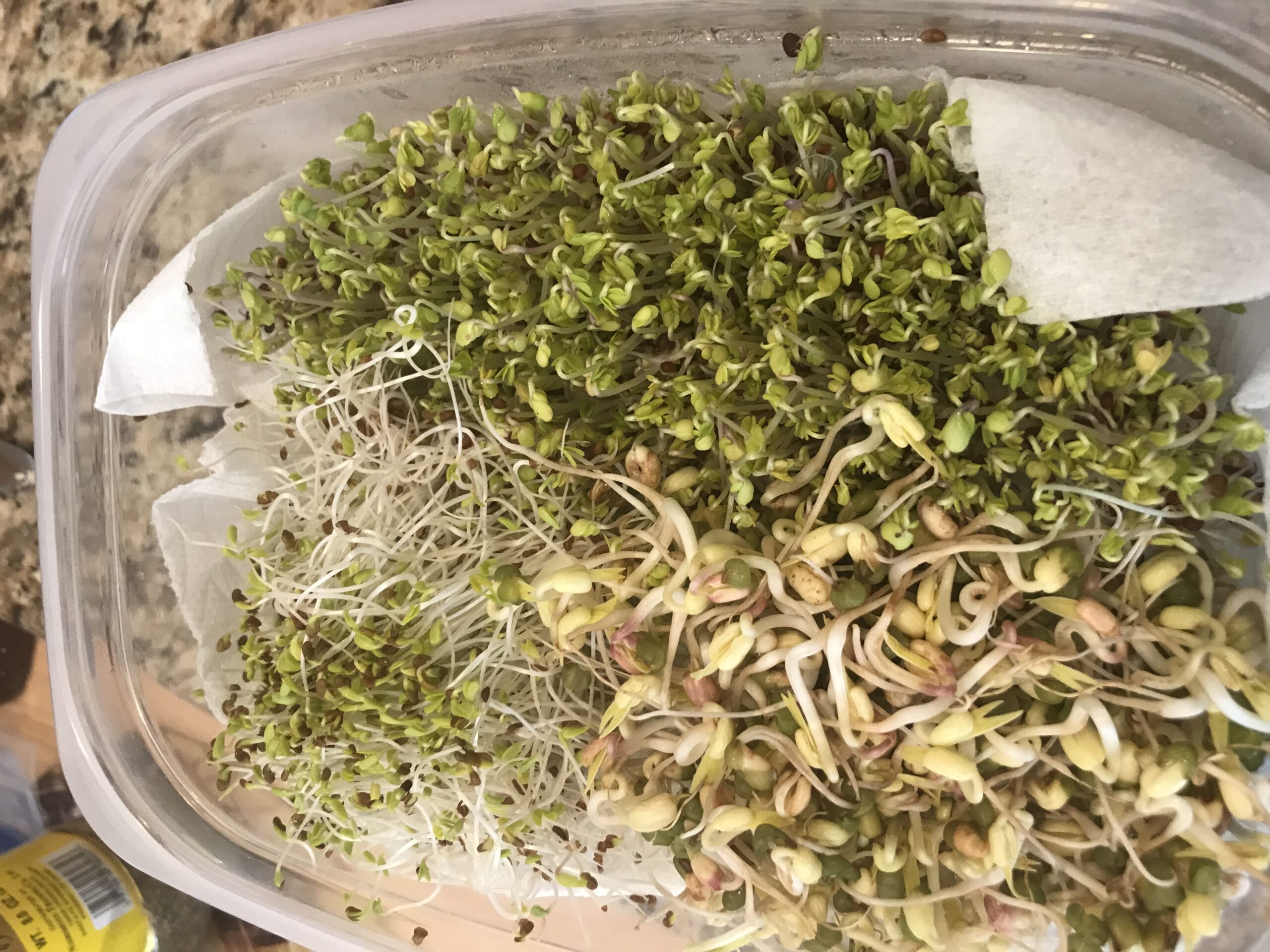Proper digestion and absorption of nutrients from plant foods, specifically grains, legumes, nuts and seeds require soaking. Sprouting and fermenting is also suggested for optimal nutrition. Planning ahead is important but really takes little time.
Seeds from a grain, legume or nut have enzyme inhibitors, phytates, and lectins that protect the seed from the elements. Until the conditions are just right, the seed will germinate into a new plant. When the enzyme inhibitors are still in place, we have trouble digesting these seeds. This is where soaking and sprouting comes in.
According to WebMD, sprouting may make it easier to absorb nutrition from these foods and some sprouts like broccoli sprouts may even help prevent cancer. Sprouts tend to have more nutrition that the full-grown plant.
Soaking
Soaking nuts, seeds, and grains will release the enzyme inhibitors that are present to protect the seeds while they grow. Soaking will increase the available nutrition as well as improving digestion of these foods. Always rinse the seeds very well during and after soaking. You may dehydrate the seeds after soaking to remove the water and increase the shelf life. Otherwise, store them in cold water in a mason jar in the refrigerator and rinse the water daily to preserve them until ready to eat. See chart below for soak times.
- Fill a bowl or jar with the seed allowing room for expansion. Fill with fresh pure filtered water allowing 2-3 inches above the seed.
- After soak time is reached (or overnight), rinse seeds well in fresh cool water (exception: you can cook grains in the soak water)
- Cook or eat as you wish. Preserve in fridge in fresh water changing water daily until you are ready to use. (you can also dehydrate nuts and seeds for storage and easy snacking)
Sprouting
Sprouting times are indicated if you care to take the seed to the next step. Soaking takes the seed to the sprout state (ready to sprout). Sprouting will give the seed a tail and will be most nutritious and alive in this state. See the chart below for sprouting time (after the initial soak time).
- Soak seeds first as indicated above (overnight is usually best).
- After soak time is achieved, rinse seeds well and use a sprouting jar (with screen top for easy rinsing and air flow) or sprouting bag.
- Set sprouting jar upside down at slight angle to allow air flow and drainage to occur. Place towel over jar to avoid sunlight getting in.
- Rinse seeds 2-3 times daily for complete sprouting time (indicated in chart below)
- On last day of sprouting, allow indirect sunlight to give your sprouts some chlorophyll as they will green a bit. don’t rinse them.
- Store dry sprouts in fridge for 5 days on top of paper towel to absorb any liquid.
Fermenting
Fermenting and culturing foods aids to beneficial bacteria in the gut. The fermentation process predigests the food so it is readily available for absorption in the body. Living organisms break down this food during fermentation. In some cases, fermentation happens after soaking and sprouting like in making rejuvelac which is a fermented grain drink. Fermenting cruciferous vegetables in particular do a tremendous job of latching onto heavy metals in the body and taking them out. Examples of fermented soy foods include: miso, liquid aminos, tempeh. Other fermented foods and drinks include: rejuvelac, yogurt, kefir, kombucha, sauerkraut, kim chee, cultured vegetables.
Making sauerkraut is extremely easy as the fermentation process uses only the cabbage and salt/lemon. If fermenting other vegetables that don’t break down and release its juices as well as cabbage, a brine may be required. Some people like to also use a veggie culture to get it going. Sauerkraut and cultured veggies add a nice taste to a bowl of soup, salad, or warm grain dish to aid digestion of the meal and add beneficial bacteria in the gut.
See the soaking and sprouting chart below for your use and please comment with any questions. Happy eating! -Linda
References:
http://www.culturesforhealth.com/benefits-soaking-grains-flours-cultured-dairy
http://nourishedkitchen.com/soaking-grains-nuts-legumes
http://www.webmd.com/food-recipes/sprouting-food?page=1
Soak and Sprouting Chart
There is no need to soak: Brazil Nuts, hemp seeds, macadamia nuts, pine nuts, pistachio nuts, peanuts.
| Seeds | Soaking Time | Sprouting Time |
| Alfalfa | 8 hrs | 2-5 days |
| Clover | 4-6 hrs | 4-5 days |
| Flax | 8 hrs | n/a |
| Mustard | 8 hrs | 2-7 days |
| Pumpkin Seeds (hulled) | 8 hrs | 1 day |
| Quinoa | 2 hrs | 1 day |
| Radish | 8 hrs | 2-4 days |
| Red Clover | 8 hrs | 2-5 days |
| Sesame seeds | 8 hrs | 1-2 days |
| Sunflower seeds (hulled) | 2 hrs | 2-3 days |
| Watercress | 4-6 hrs | 4-5 days |
| Grains | ||
| Barley | 6-8 hrs | 2 days |
| Buckwheat | 6 hrs | 2 days |
| Corn | 12 hrs | 2-3 days |
| Kamut | 7 hrs | 2-3 days |
| Millet | 8 hrs | 2-3 days |
| Oat groats | 6 hrs | 2 days |
| Rye | 8 hrs | 3 days |
| Spelt | 7 hrs | 2 days |
| Wheatberries | 7 hrs | 2-3 days |
| Wild Rice | 9 hrs | 3-5 days |
| Nuts | ||
| Almonds | 8-12 hrs | 12 hrs |
| Cashews | 2-3 hrs | n/a |
| Pecans | 4-6 hrs | n/a |
| Walnuts | 4 hrs | n/a |
| Beans/Legumes | ||
| Adzuki | 12 hrs | 3-5 days |
| Chickpeas | 12 hrs | 12 hours |
| Green peas | 12 hrs | 2-3 days |
| Lentils | 8 hrs | 12 hrs |
| Mung Beans | 1 day | 2-5 days |

